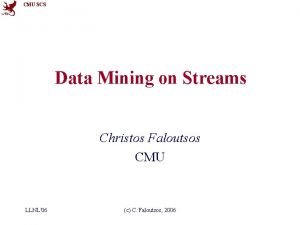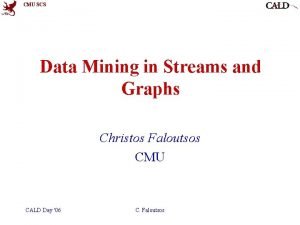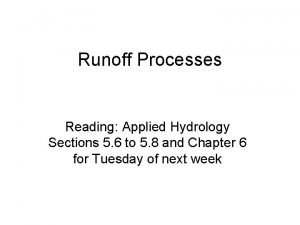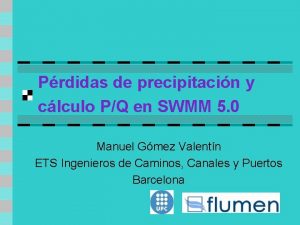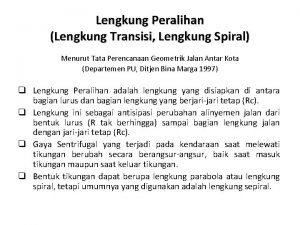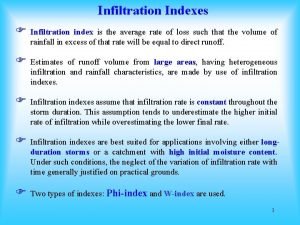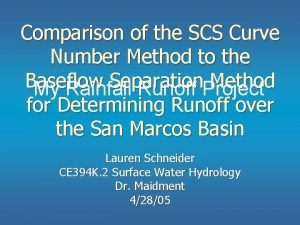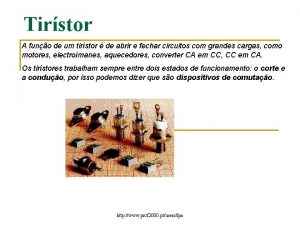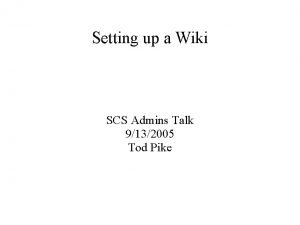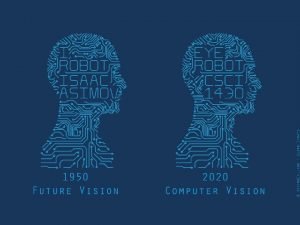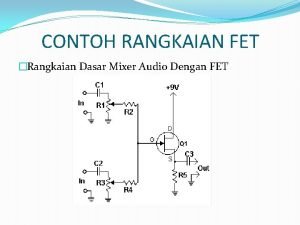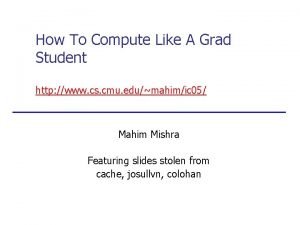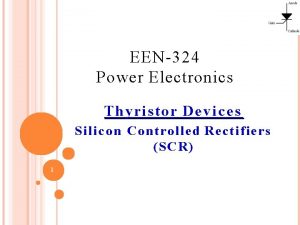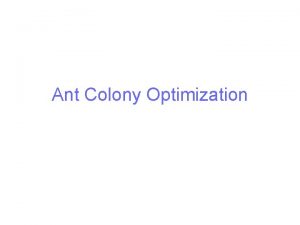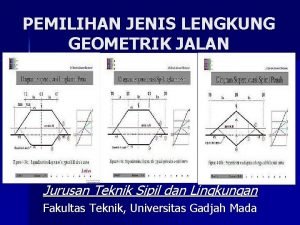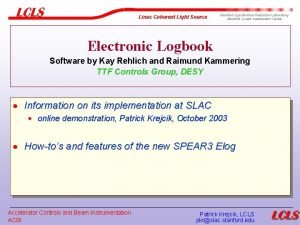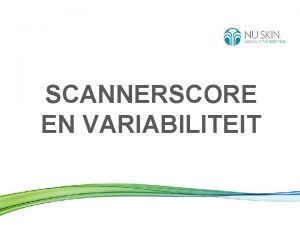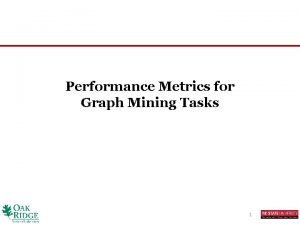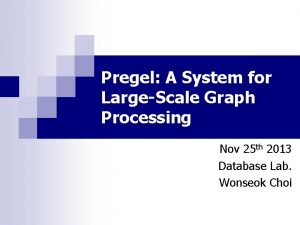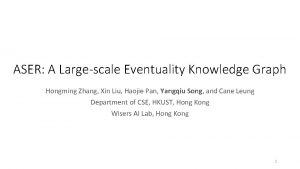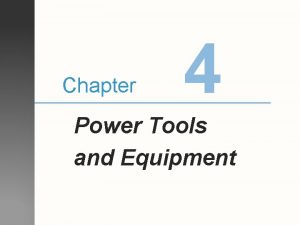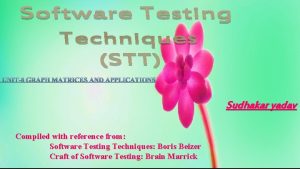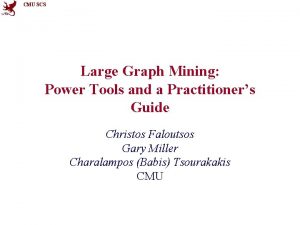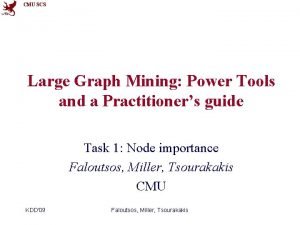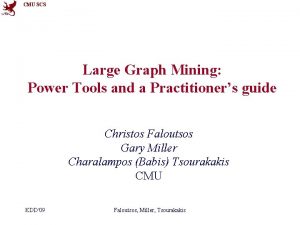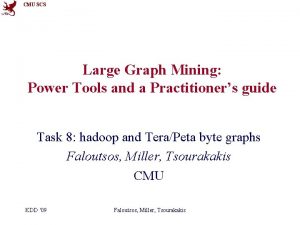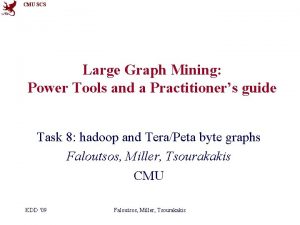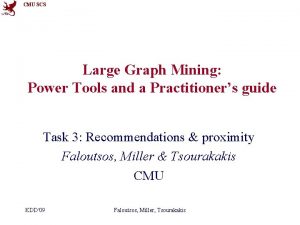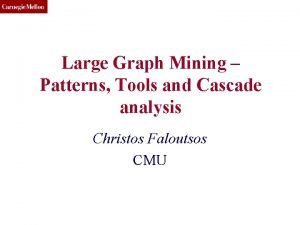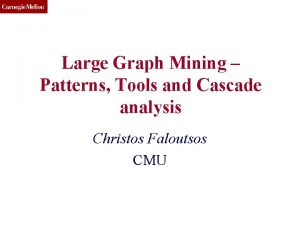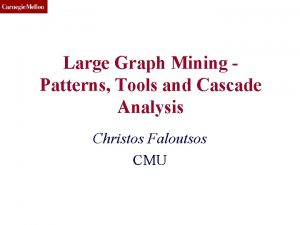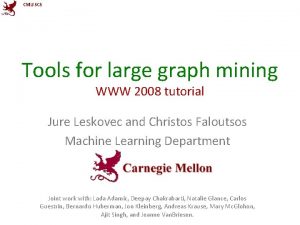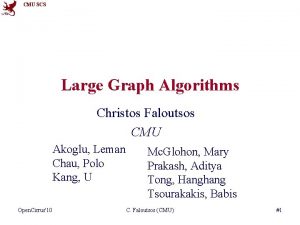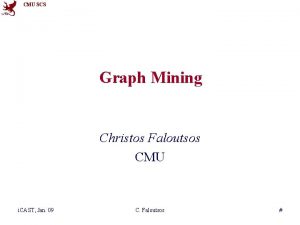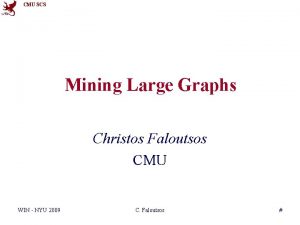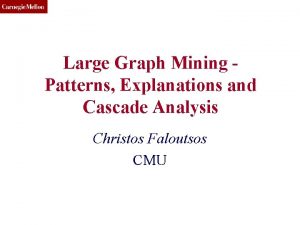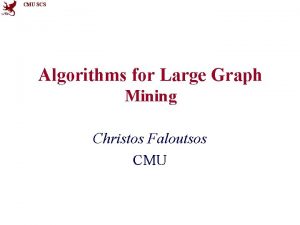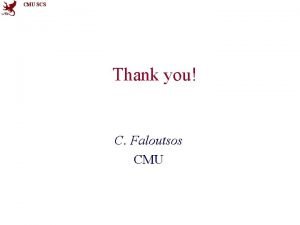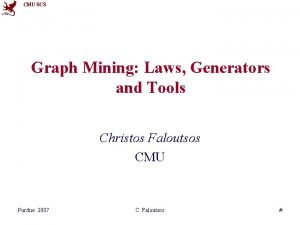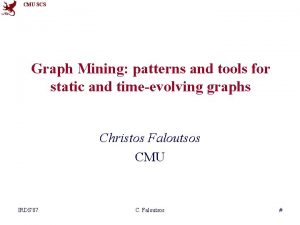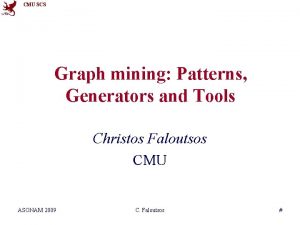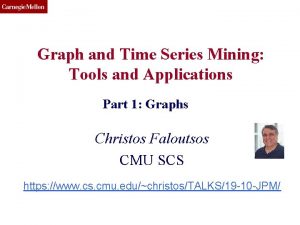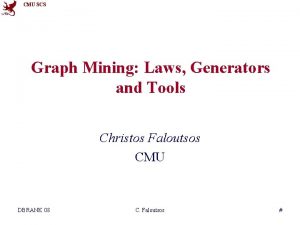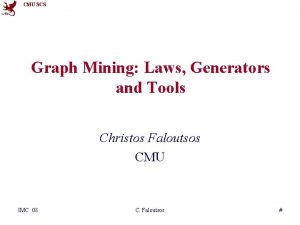CMU SCS Large Graph Mining Power Tools and































![CMU SCS Algorithm • Hadoop implementation [ICDM’ 08] Spiros Papadimitriou, Jimeng Sun: Dis. Co: CMU SCS Algorithm • Hadoop implementation [ICDM’ 08] Spiros Papadimitriou, Jimeng Sun: Dis. Co:](https://slidetodoc.com/presentation_image/e42a3103dbf5b14944919e46b3279c30/image-32.jpg)




![CMU SCS Jellyfish model [Tauro+] … A Simple Conceptual Model for the Internet Topology, CMU SCS Jellyfish model [Tauro+] … A Simple Conceptual Model for the Internet Topology,](https://slidetodoc.com/presentation_image/e42a3103dbf5b14944919e46b3279c30/image-37.jpg)










- Slides: 47

CMU SCS Large Graph Mining: Power Tools and a Practitioner’s guide Task 2: Community Detection Faloutsos, Miller, Tsourakakis CMU KDD'09 Faloutsos, Miller, Tsourakakis

CMU SCS Outline • • • Introduction – Motivation Task 1: Node importance Task 2: Community detection Task 3: Recommendations Task 4: Connection sub-graphs Task 5: Mining graphs over time Task 6: Virus/influence propagation Task 7: Spectral graph theory Task 8: Tera/peta graph mining: hadoop Observations – patterns of real graphs Conclusions KDD'09 Faloutsos, Miller, Tsourakakis

CMU SCS Detailed outline • • • Motivation Hard clustering – k pieces Hard co-clustering – (k, l) pieces Hard clustering – optimal # pieces Observations KDD'09 Faloutsos, Miller, Tsourakakis 3

CMU SCS Problem • Given a graph, and k • Break it into k (disjoint) communities KDD'09 Faloutsos, Miller, Tsourakakis 4

CMU SCS Problem • Given a graph, and k • Break it into k (disjoint) communities k=2 KDD'09 Faloutsos, Miller, Tsourakakis 5

CMU SCS Solution #1: METIS • Arguably, the best algorithm • Open source, at – http: //www. cs. umn. edu/~metis • and *many* related papers, at same url • Main idea: – coarsen the graph; – partition; – un-coarsen KDD'09 Faloutsos, Miller, Tsourakakis 6

CMU SCS Solution #1: METIS • G. Karypis and V. Kumar. METIS 4. 0: Unstructured graph partitioning and sparse matrix ordering system. TR, Dept. of CS, Univ. of Minnesota, 1998. • <and many extensions> KDD'09 Faloutsos, Miller, Tsourakakis 7

CMU SCS Solution #2 (problem: hard clustering, k pieces) Spectral partitioning: • Consider the 2 nd smallest eigenvector of the (normalized) Laplacian See details in ‘Task 7’, later KDD'09 Faloutsos, Miller, Tsourakakis 8

CMU SCS Solutions #3, … Many more ideas: • Clustering on the A 2 (square of adjacency matrix) [Zhou, Woodruff, PODS’ 04] • Minimum cut / maximum flow [Flake+, KDD’ 00] • … KDD'09 Faloutsos, Miller, Tsourakakis 9

CMU SCS Detailed outline • • • Motivation Hard clustering – k pieces Hard co-clustering – (k, l) pieces Hard clustering – optimal # pieces Soft clustering – matrix decompositions Observations KDD'09 Faloutsos, Miller, Tsourakakis 10

CMU SCS Problem definition • Given a bi-partite graph, and k, l • Divide it into k row groups and l row groups • (Also applicable to uni-partite graph) KDD'09 Faloutsos, Miller, Tsourakakis 11

CMU SCS Co-clustering • Given data matrix and the number of row and column groups k and l • Simultaneously – Cluster rows into k disjoint groups – Cluster columns into l disjoint groups KDD'09 Faloutsos, Miller, Tsourakakis

CMU SCS Co-clustering • Let X and Y be discrete random variables – X and Y take values in {1, 2, …, m} and {1, 2, …, n} – p(X, Y) denotes the joint probability distribution—if not known, it is often estimated based on co-occurrence data – Application areas: text mining, market-basket analysis, analysis of browsing behavior, etc. • Key Obstacles in Clustering Contingency Tables – High Dimensionality, Sparsity, Noise – Need for robust and scalable algorithms Reference: KDD'09 Copyright: Faloutsos, Miller, Tsourakakis Tong (2009) 1. Dhillon et al. Information-Theoretic Co-clustering, KDD’ 03 2 -

CMU SCS n eg, terms x documents m k l k n l m KDD'09 Faloutsos, Miller, Tsourakakis

CMU SCS med. doc cs doc med. terms cs term group x doc. group common terms doc x doc group term x KDD'09 term-group Faloutsos, Miller, Tsourakakis

CMU SCS Co-clustering Observations • uses KL divergence, instead of L 2 • the middle matrix is not diagonal – we’ll see that again in the Tucker tensor decomposition • s/w at: www. cs. utexas. edu/users/dml/Software/cocluster. html KDD'09 Faloutsos, Miller, Tsourakakis

CMU SCS Detailed outline • • • Motivation Hard clustering – k pieces Hard co-clustering – (k, l) pieces Hard clustering – optimal # pieces Soft clustering – matrix decompositions Observations KDD'09 Faloutsos, Miller, Tsourakakis 17

CMU SCS Problem with Information Theoretic Co-clustering • Number of row and column groups must be specified Desiderata: ü Simultaneously discover row and column groups Fully Automatic: No “magic numbers” ü Scalable to large graphs KDD'09 Faloutsos, Miller, Tsourakakis 18

CMU SCS Cross-association Desiderata: ü Simultaneously discover row and column groups ü Fully Automatic: No “magic numbers” ü Scalable to large matrices Reference: KDD'09 Faloutsos, Miller, Tsourakakis 1. Chakrabarti et al. Fully Automatic Cross-Associations, KDD’ 04 19

CMU SCS versus Column groups KDD'09 Why is this better? Row groups What makes a cross-association “good”? Column groups Faloutsos, Miller, Tsourakakis 20

CMU SCS versus Column groups Why is this better? Row groups What makes a cross-association “good”? Column groups simpler; easier to describe easier to compress! KDD'09 Faloutsos, Miller, Tsourakakis 21

CMU SCS What makes a cross-association “good”? Problem definition: given an encoding scheme • decide on the # of col. and row groups k and l • and reorder rows and columns, • to achieve best compression KDD'09 Faloutsos, Miller, Tsourakakis 22

CMU SCS Main Idea Good Compression Total Encoding Cost = Better Clustering Cost of describing size * H(x ) + Σi i i cross-associations Code Cost Description Cost Minimize the total cost (# bits) for lossless compression KDD'09 Faloutsos, Miller, Tsourakakis 23

CMU SCS Algorithm l = 5 col groups k = 5 row groups k=1, l=2 KDD'09 k=2, l=2 k=2, l=3 k=3, l=4 Faloutsos, Miller, Tsourakakis k=4, l=4 k=4, l=5 24

CMU SCS Experiments Documents “CLASSIC” • 3, 893 documents • 4, 303 words • 176, 347 “dots” Words Combination of 3 sources: • MEDLINE (medical) • CISI (info. retrieval) • CRANFIELD (aerodynamics) KDD'09 Faloutsos, Miller, Tsourakakis 25

CMU SCS Documents Experiments Words “CLASSIC” graph of documents & KDD'09 Faloutsos, Miller, Tsourakakis words: k=15, l=19 26

CMU SCS Experiments insipidus, alveolar, aortic, death, prognosis, intravenous blood, disease, clinical, cell, tissue, patient MEDLINE (medical) “CLASSIC” graph of documents & KDD'09 Faloutsos, Miller, Tsourakakis words: k=15, l=19 27

CMU SCS Experiments providing, studying, records, development, students, rules abstract, notation, works, construct, bibliographies MEDLINE (medical) CISI (Information Retrieval) “CLASSIC” graph of documents & KDD'09 Faloutsos, Miller, Tsourakakis words: k=15, l=19 28

CMU SCS Experiments shape, nasa, leading, assumed, thin MEDLINE (medical) CISI (Information Retrieval) CRANFIELD (aerodynamics) “CLASSIC” graph of documents & KDD'09 Faloutsos, Miller, Tsourakakis words: k=15, l=19 29

CMU SCS Experiments paint, examination, fall, raise, leave, based MEDLINE (medical) CISI (Information Retrieval) CRANFIELD (aerodynamics) “CLASSIC” graph of documents & KDD'09 Faloutsos, Miller, Tsourakakis words: k=15, l=19 30

CMU SCS Algorithm Code for cross-associations (matlab): www. cs. cmu. edu/~deepay/mywww/software/Cross. Associations 01 -27 -2005. tgz Variations and extensions: • ‘Autopart’ [Chakrabarti, PKDD’ 04] • www. cs. cmu. edu/~deepay KDD'09 Faloutsos, Miller, Tsourakakis 31
![CMU SCS Algorithm Hadoop implementation ICDM 08 Spiros Papadimitriou Jimeng Sun Dis Co CMU SCS Algorithm • Hadoop implementation [ICDM’ 08] Spiros Papadimitriou, Jimeng Sun: Dis. Co:](https://slidetodoc.com/presentation_image/e42a3103dbf5b14944919e46b3279c30/image-32.jpg)
CMU SCS Algorithm • Hadoop implementation [ICDM’ 08] Spiros Papadimitriou, Jimeng Sun: Dis. Co: Distributed Co-clustering with Map. Reduce: A Case Study towards Petabyte-Scale End-to-End Mining. ICDM KDD'09 Faloutsos, Miller, Tsourakakis 32 2008: 512 -521

CMU SCS Detailed outline • • • Motivation Hard clustering – k pieces Hard co-clustering – (k, l) pieces Hard clustering – optimal # pieces Observations KDD'09 Faloutsos, Miller, Tsourakakis 33

CMU SCS Observation #1 • Skewed degree distributions – there are nodes with huge degree (>O(10^4), in facebook/linked. In popularity contests!) KDD'09 Faloutsos, Miller, Tsourakakis 34

CMU SCS Observation #2 • Maybe there are no good cuts: ``jellyfish’’ shape [Tauro+’ 01], [Siganos+, ’ 06], strange behavior of cuts [Chakrabarti+’ 04], [Leskovec+, ’ 08] KDD'09 Faloutsos, Miller, Tsourakakis 35

CMU SCS Observation #2 • Maybe there are no good cuts: ``jellyfish’’ shape [Tauro+’ 01], [Siganos+, ’ 06], strange behavior of cuts [Chakrabarti+, ’ 04], [Leskovec+, ’ 08] ? KDD'09 ? Faloutsos, Miller, Tsourakakis 36
![CMU SCS Jellyfish model Tauro A Simple Conceptual Model for the Internet Topology CMU SCS Jellyfish model [Tauro+] … A Simple Conceptual Model for the Internet Topology,](https://slidetodoc.com/presentation_image/e42a3103dbf5b14944919e46b3279c30/image-37.jpg)
CMU SCS Jellyfish model [Tauro+] … A Simple Conceptual Model for the Internet Topology, L. Tauro, C. Palmer, G. Siganos, M. Faloutsos, Global Internet, November 25 -29, 2001 Jellyfish: A Conceptual Model for the AS Internet Topology G. Siganos, Sudhir L Tauro, M. Faloutsos, J. of Communications and Networks, Vol. 8, No. 37 3, pp KDD'09 Faloutsos, Miller, Tsourakakis 339 -350, Sept. 2006.

CMU SCS Strange behavior of min cuts • ‘negative dimensionality’ (!) Net. Mine: New Mining Tools for Large Graphs, by D. Chakrabarti, Y. Zhan, D. Blandford, C. Faloutsos and G. Blelloch, in the SDM 2004 Workshop on Link Analysis, Counter-terrorism and Privacy Statistical Properties of Community Structure in Large Social and Information K. Tsourakakis Lang, A. Dasgupta, M. Mahoney. KDD'09 Networks, J. Leskovec, Faloutsos, Miller, 38 WWW 2008.

CMU SCS “Min-cut” plot • Do min-cuts recursively. log (mincut-size / #edges) Mincut size = sqrt(N) log (# edges) N nodes KDD'09 Faloutsos, Miller, Tsourakakis 39

CMU SCS “Min-cut” plot • Do min-cuts recursively. New min-cut log (mincut-size / #edges) log (# edges) N nodes KDD'09 Faloutsos, Miller, Tsourakakis 40

CMU SCS “Min-cut” plot • Do min-cuts recursively. New min-cut log (mincut-size / #edges) Slope = -0. 5 log (# edges) N nodes KDD'09 For a d-dimensional grid, the slope is -1/d Faloutsos, Miller, Tsourakakis 41

CMU SCS “Min-cut” plot log (mincut-size / #edges) Slope = -1/d log (# edges) For a d-dimensional grid, the slope is -1/d KDD'09 For a random graph, the slope is 0 Faloutsos, Miller, Tsourakakis 42

CMU SCS “Min-cut” plot • What does it look like for a real-world graph? log (mincut-size / #edges) ? log (# edges) KDD'09 Faloutsos, Miller, Tsourakakis 43

CMU SCS Experiments • Datasets: – Google Web Graph: 916, 428 nodes and 5, 105, 039 edges – Lucent Router Graph: Undirected graph of network routers from www. isi. edu/scan/mercator/maps. html; 112, 969 nodes and 181, 639 edges – User Website Clickstream Graph: 222, 704 nodes and 952, 580 edges Net. Mine: New Mining Tools for Large Graphs, by D. Chakrabarti, Y. Zhan, D. Blandford, C. Faloutsos and G. Blelloch, in the SDM 2004 KDD'09 Faloutsos, Miller, Tsourakakis 44 Workshop on Link Analysis, Counter-terrorism and Privacy

CMU SCS Experiments log (mincut-size / #edges) • Used the METIS algorithm [Karypis, Kumar, 1995] Slope~ -0. 4 • Values along the yaxis are averaged • We observe a “lip” for large edges log (# edges) KDD'09 • Google Web graph • Slope of -0. 4, corresponds to a 2. 5 dimensional grid! Faloutsos, Miller, Tsourakakis 45

CMU SCS Experiments Slope~ -0. 57 log (mincut-size / #edges) • Same results for other graphs too… Slope~ -0. 45 log (# edges) Lucent Router graph KDD'09 Clickstream graph Faloutsos, Miller, Tsourakakis 46

CMU SCS Conclusions – Practitioner’s guide • • METIS Hard clustering – k pieces Co-clustering Hard co-clustering – (k, l) pieces Hard clustering – optimal # pieces Cross-associations ‘jellyfish’: Observations Maybe, there are no good cuts KDD'09 Faloutsos, Miller, Tsourakakis 47
 Travin hazelrigg
Travin hazelrigg Data mining cmu
Data mining cmu Cmu data mining
Cmu data mining Difference between strip mining and open pit mining
Difference between strip mining and open pit mining Difference between text mining and web mining
Difference between text mining and web mining Strip mining vs open pit mining
Strip mining vs open pit mining Mineral resources and mining chapter 13
Mineral resources and mining chapter 13 Mining multimedia databases in data mining
Mining multimedia databases in data mining Mining complex types of data
Mining complex types of data Cmu graph theory
Cmu graph theory Reporting and query tools in data mining
Reporting and query tools in data mining Real power formula
Real power formula Scs method
Scs method Lluvia neta
Lluvia neta Spiral circle spiral
Spiral circle spiral Scs curve number
Scs curve number Dioda diac
Dioda diac Scs curve number
Scs curve number Scs tiristor
Scs tiristor Color 9132005
Color 9132005 Scs.ryerson.ca harley
Scs.ryerson.ca harley Rangkaian fet
Rangkaian fet Scs reasonable person principle
Scs reasonable person principle Scs thyristor
Scs thyristor Scs carleton
Scs carleton Scs archiver
Scs archiver Jenis lengkung
Jenis lengkung Scs elogs
Scs elogs Scs lulu
Scs lulu Scs methode
Scs methode Doc scs
Doc scs Scs scanner
Scs scanner Arabesque: a system for distributed graph mining
Arabesque: a system for distributed graph mining How should mining graph look like
How should mining graph look like Pregel: a system for large-scale graph processing
Pregel: a system for large-scale graph processing Aser: a large-scale eventuality knowledge graph
Aser: a large-scale eventuality knowledge graph Wait-for graph
Wait-for graph Hand tool safety quiz
Hand tool safety quiz Osha power tools must be fitted with guards and
Osha power tools must be fitted with guards and Osha hand and power tools
Osha hand and power tools Identify hazards
Identify hazards Chapter 4 power tools and equipment
Chapter 4 power tools and equipment Osha power tools must be fitted with guards and
Osha power tools must be fitted with guards and Osha power tools must be fitted with guards and
Osha power tools must be fitted with guards and Marking tools in sewing
Marking tools in sewing Algori
Algori Handshaking theorem
Handshaking theorem Solar power satellites and microwave power transmission
Solar power satellites and microwave power transmission

